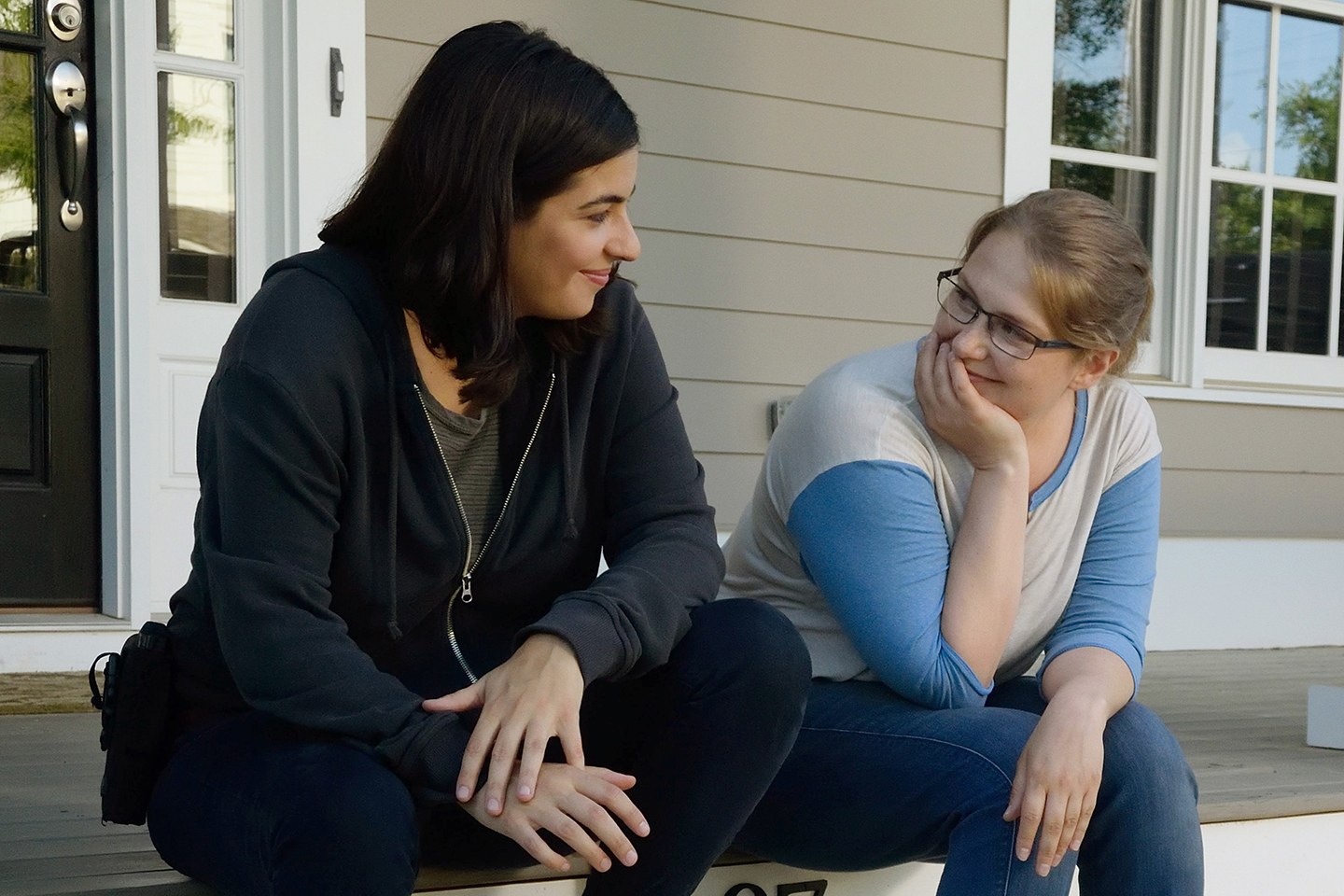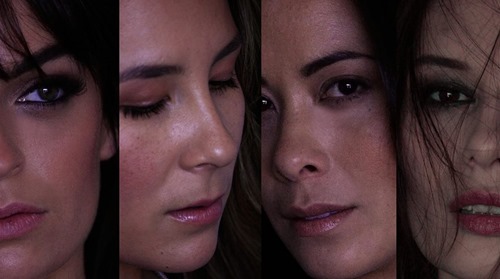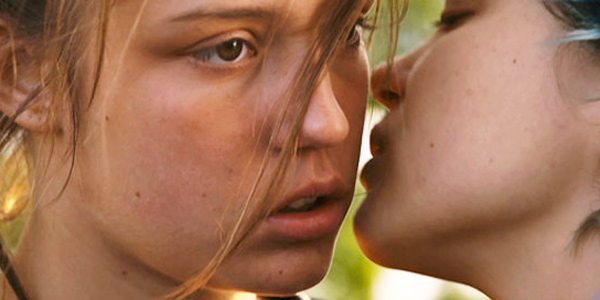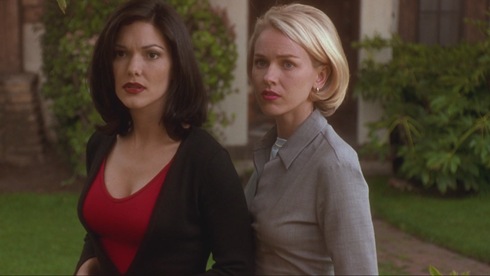This is a guest post written by Eva Phillips.
Rarely do the shows that I rapturously and actively nerd-gasm correspond with shows that I eagerly seek out for positive or intriguing queer narratives. With the exceptions of Orphan Black, the ever-confounding subplots on American Horror Story and my nostalgic revisiting of Star Trek and Battlestar Galactica, my queer reading of nerd-tastic texts is often relegated to the imagined on my part, and infrequently prominently feature explicitly queer characters and storylines for more than an episode or two. Thus, this piece originated as a way of professing my adoration for one of the few queer characters (and her consequent queer relationship) that happened to emerge in one of my most cherished nerd-series of all time (for better or for worse). And then, upon beginning to pen my praises, a really enraging media-kerfuffle transpired involving Amy Schumer, and the irritatingly age-old issue of discussing and analyzing women’s body image and size based on language that strips them of their autonomy resurfaced yet again. My vitriolic response to the uproar then galvanized me to reconceptualize my piece, reexamining my thoughts on the character/relationship I so adored in the context of its statement on body/selfhood positivity and assertion in conjunction with its queer elevation.
So given that buildup, it might seem a bit peculiar that the show that I chose to write on is the oft-beleaguered AMC giant, The Walking Dead. But perhaps halt scorn for a moment. For a show that started off with some of the most flamboyantly misogynistic storylines, machismo engorged characters, T Dogg and “the problem of race”, and manipulatively or even scurrilously portrayed women (the laughably awful attempt to cast Lori as some sort of Lady Macbeth in Season 2? Always a personal “favorite”), The Walking Dead has surprisingly evolved into one of the more complex, multi-persona infused shows. Though it may not be the pinnacle of diversity in the ever-expanding canopy of televisual representation, and it is plagued by some of the worrisome trends of disregarding certain actors (like the irksome detail of Sonequa Martin Green’s late addition to the main credits three season into her stint, compared to Michael Cudlitz’s and Lennie James’ nearly immediate additions).

Tara first appears in the Season Four episode “Live Bait”— which, much to my dismay, was not a standalone episode about a dive-y post-apocalyptic leather bar, but, rather, was a clunky mid-season re-introduction of everyone’s favorite sociopath, The Governor. Fairly pointless things happen throughout the episode’s vignette — he calls himself “Brian,” he gently carries a sickly man, he seems to have a disassociative break from his murderous self, and he develops paternal feelings for a little girl (essentially tacitly promising her a grisly death to continue his pretty dismal parenting record). But aside from “Brian” grumbling around and somehow seducing everyone (how, though? Really? Even Merle had more charisma…) there’s this spunky woman who greets us, pistol at the ready, who hastens to inform “Brian” that she is a star member of the Atlanta police force and has sufficient ammunition to kill “Brian” every day for the next ten years (which, may have not been a terrible idea for a TWD spinoff). This gal with all the chutzpah, of course, is Tara Chambers, significant for being all at once beautifully awkward, savagely protective — she is the watchdog of her niece (the aforementioned little girl, Megan), her father (the aforementioned sickly man), and her utterly milquetoast sister, Lilly — endearingly aggressive yet naïve (she poignantly calls the walkers “monsters,” and shoots them repeatedly, unaware of the “get the brain” rule), and, most importantly, she is profoundly, blissfully queer. Even if, in the final ten minutes of the episode, we weren’t graced with the subtle, all-too-familiar tale exchanged between Tara and Lilly about a camping trip, ‘shrooms, and a confession from a female love interest had a boyfriend, Tara would be the most marvelously encoded queer character to feature in The Walking Dead. Tara swears (at least, by AMC standards) effusively, she is some peculiar admixture of savage, quirky and mournful. She has a belligerent insistence that literally every significant event (including, in her premiere episode, “Brian’s” swift action to put-down her deceased father) must be concluded or heralded with a fist-bump. Actor Alana Masterson efficaciously embodies a character who not only proudly and openly personifies timidly-badass queer femininity, but makes each scene Tara is in meaningful, rather than getting lost in the shuffle of often interchangeable TWD secondary characters (or the, “Are You There God, It’s Me Beth/Bob/Rosita” syndrome that tends to be virulent in the series).
Certainly, there are many praises and vexations to profess when dissecting Tara’s trajectory and character arch, the praise portion of which I would certainly make as rich and embellished as possible because aside from the gorgeous enigma that is Carol, Tara is arguably one of my most beloved characters, living or (un)dead. There’s the really lovely (and it is enraging that character development of queer folk is met with gratefulness) stretch throughout the haphazard, at times brilliant, chaos of seasons four and five, in which Tara develops when she could have been marginalized or left behind. She has some of the most harrowing and compelling storylines. Her entire remaining family suffers the direst walkers’ fate; she realizes the monstrous sociopathy of “Brian’s” vengeance (yelling at her soon-to-perish, then-girlfriend “he chopped a guy’s head off…WITH A SWORD”); upon managing to be one of the two survivors in the husk of the prison, she accompanies, aids and bonds with Glenn; she manages to forge a place in the group and with Rick despite her origins, and develops a quirky little family unit with Rosita, Eugene and Rosita (and later, poor, poor Noah). Not only does her character’s spark never diminish, she is consistently given stellar dialogue, both punchy and sympathetic (her rapport with Eugene is often a highlight), and she rocks some of the most fantastically gay flannel cut-offs that inspire me to greatness.

What is most crucial about Tara, and Alana Masterson’s consistently wonderful portrayal, that really consecrates her deserved spot in the television tradition of marvelously queer Taras, is the space her queerness inhabits and the implicit, resounding body positivity that is manifest in her season six relationship with the affably tragic Denise Cloyd. One of the vexations of Tara’s narrative, and of the show in general, is the virtual nonexistence of queer intimacy and sexuality, particularly given the bevvy of coital exchanges between Maggie and Glenn, and the scantily clad entanglements of Rick and Lori, Rick and Michonne, and even Abraham and Rosita. Tara’s intimacy with her partners is diluted and nearly G-rated, though it is given more attention than her queer peer Aaron and his beau Eric (who, much to my surprise, is still alive — I rewatched the series and thought, “This is surely the episode where Eric dies of a broken ankle or succumbs to scurvy,” but, nope. Still kicking). To address the egregiously dissatisfying matter of disproportionately shown queer sexuality, or the consequent deeming of even queer kisses as “controversial,” would be a really vitriolic and speculative piece all its own.
Rather, what is worth discussing, what I felt so impressed upon to discuss is the way in which Tara’s body exists – she is never exoticized or eroticized, Tara is both beautiful and uniquely, ceaselessly quirky. Her queerness is neither othered nor, arguably more infuriating, forcibly normalized (there is no asinine moment of, “Well, I mean, it’s totally cool that you’re a lesbian.”). Importantly, Tara’s body is allowed to exist in its own right — it is not commodified, positioned, or stylized in a way to be the sexy sapphic chick or the archetypal granola-y/exaggeratedly butch/desexualized lesbian. She is an organic woman with no caricatures clinging to her presentation of self.
This is no more evident and worth celebrating than in the unexpected relationship between Tara and Denise that begins in the season six episode “Now” and flourishes throughout the entirety of the season. Their fire is kindled, so to speak, in the devastating wake of the Wolves attack in “JSS,” and is established on a foundation of moral support (Tara inspires Denise to trust in her medical prowess as she is thrust into the role of Alexandria’s sole doctor), protection and genuine care for one another (Denise asking Daryl to fetch soda for Tara because she talks about it in her sleep is particularly lovely) and just general, unique adorableness. The two even share a winking, encoded, dialogue exchange after Denise initiates the relationship by kissing Tara on the steps, and Denise, presumably referring to, you know, the zombies and all states, “It’s the end of the world,” to which Tara coolly retorts, “No… it’s not.” Amidst all that effulgent splendor and healthiness of a relationship ensconced in decay and turmoil, the most pleasantly surprising element of Tara and Denise (who really need a portmanteau name… Tanise? Rase? Dera? I’ll think of something) is the profound body positivity they embody together and as a couple. Both Tara and Denise — played by the outrageously talented Merritt Wever, who if you are not aware of, you need to familiarize yourself with immediately — are women who may be categorized in certain body types, but to do so would be a blunder. They are beautiful, complex women whose beauty is iridescent in their auras and their fluidity with, attraction to and reliance upon one another. Moreover, they are not hyper-sexualized nor isolated in a realm of frumpy, sexless lesbian portrayal. It is a queer relationship, and a depiction of two women, that thrives on the essence of just being – that is to say that their love and their selves resonate and matter for their own beauty and their own actions; not some essentialized, picked apart, or commodified representation.
That is really at the heart of the matter in why Denise’s savage death in the final episodes of season 6 is so brutal. It’s not simply that it painfully falls into the abhorrent Bury Your Gays trope — Denise gets killed in an attempt to find both soda (for Tara) and inner-strength to be able to tell Tara she loves her (which she resolves to do) — it is that her death signifies the violent and agonizing (not hyperbolic, I’m very attached to these characters) end to a queer relationship that wasn’t steeped in unrealistic or unnecessary stereotyping. Tara and Denise were relatable, despite their outlandishly gloomy environment, and as a couple they embodied a wholly body positive, wholly natural union, albeit forged in the midst of guts and splatter.
The ever-enchanting Merritt Wever, in an interview following the shockwaves of Denise’s vicious arrow-through-the-eye demise (a demise, importantly, intended for Übermensch white dude Abraham in the comics), echoed the heteronormative, unintended privilege of not comprehending the loss of such a character to a queer audience. Beyond her remarks, that there was a sincere failure, in all likelihood, to acknowledge that Denise’s death would be seen as a blight on queer televisual representation, there is a certain melancholy in mourning a relationship that was characterized by body positivity and queer elevation. As a woman who came of age and came to terms with queerness in cooperation with my obsession with television and film, the plethora of queer bodies and queer relationships I watched that fixated on distortedly immaculate physicalities — or, conversely, mocked or marginalized bodies — and reveled in some sensationalized type of sexuality so warped my perception, that to have a relationship like Tara and Denise’s was such a glorious prize. Moreover, in a time where femininity is so ensnared in the constant rhetoric surrounding the sizing of women’s bodies, and fixating on labels and valorizing or castigating a language of weight and body image that completely reduces feminine identity, to have two strong and two queer women feature prominently in a way that refuses to submit to those standards and dialogues is such a boon in so many regards.
Lamenting Denise’s death is certainly deserved, though it should not completely occlude the impact Tara as a character had and will continue to have (once her never-ending supplies run ends after Alana Masterson’s IRL pregnancy). Tara, in her own right, is a formidable character, and as a testament to her character’s appeal and magnificence, she has existed and championed in a series whose literary counterpart she did not even exist in (or so I’m told, because I’m the worst kind of TWD nerd who abstains from the comics). Her flawless presence and uncompromising, uncommodified self and queerness is only the decadent icing on an already pretty phenomenal, fist-bumping cake. Moreover, Tara is one of the few characters that has actually catalyzed me to pine to be fictitious — after all, she’ll probably need a shoulder to cry on after returning to the Negan-sowed chaos in the upcoming season.
Eva Phillips is constantly surprised at how remarkably Southern she in fact is as she adjusts to social and climate life in The Steel City. Additionally, Eva thoroughly enjoys completing her Master’s Degree in English, though really wishes that more of her grades could be based on how well she researches Making a Murderer conspiracy theories whilst pile-driving salt-and-vinegar chips. You can follow her on Instagram at @menzingers2.












